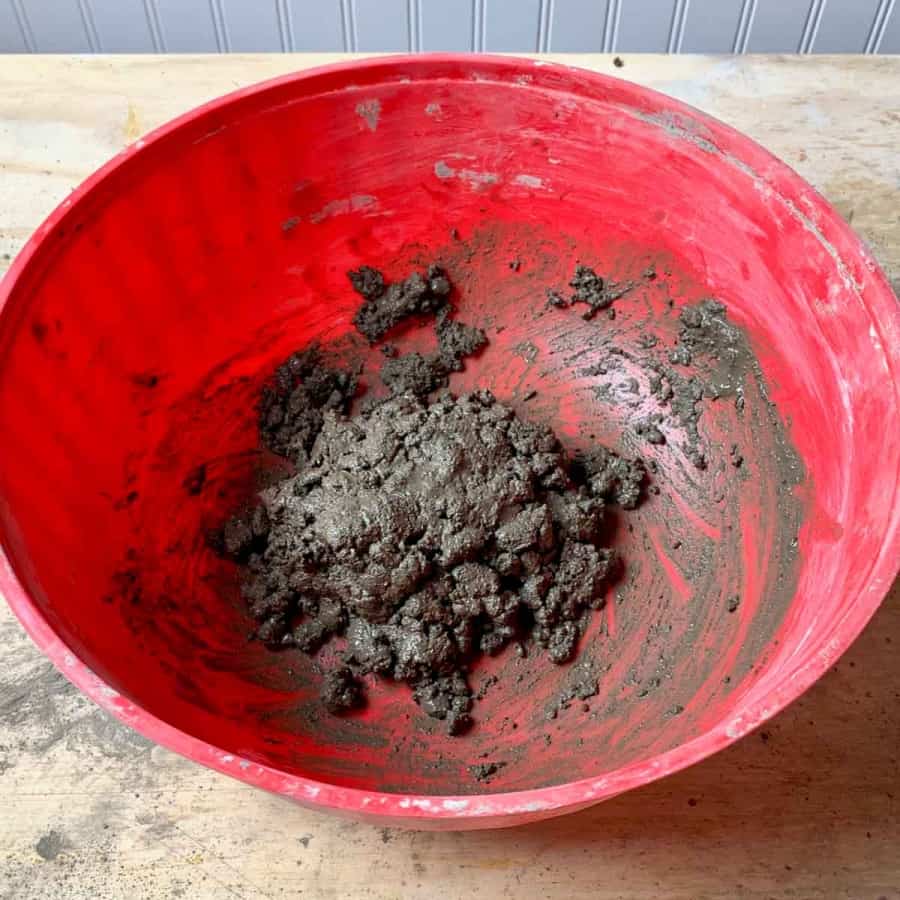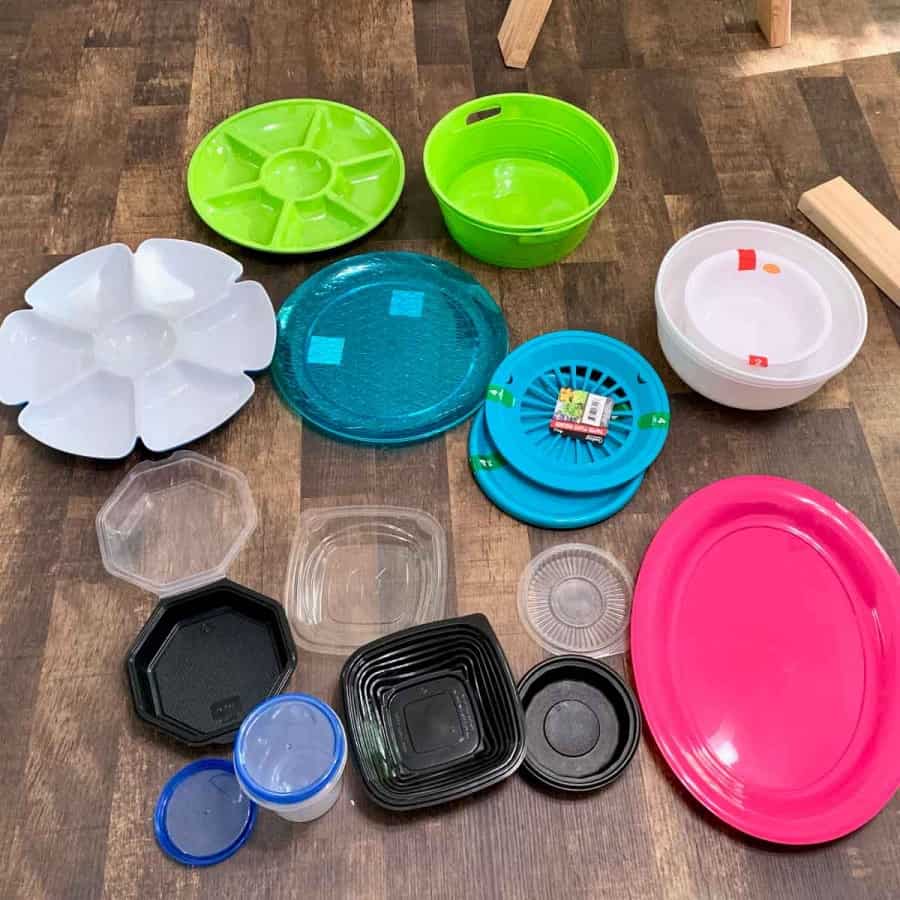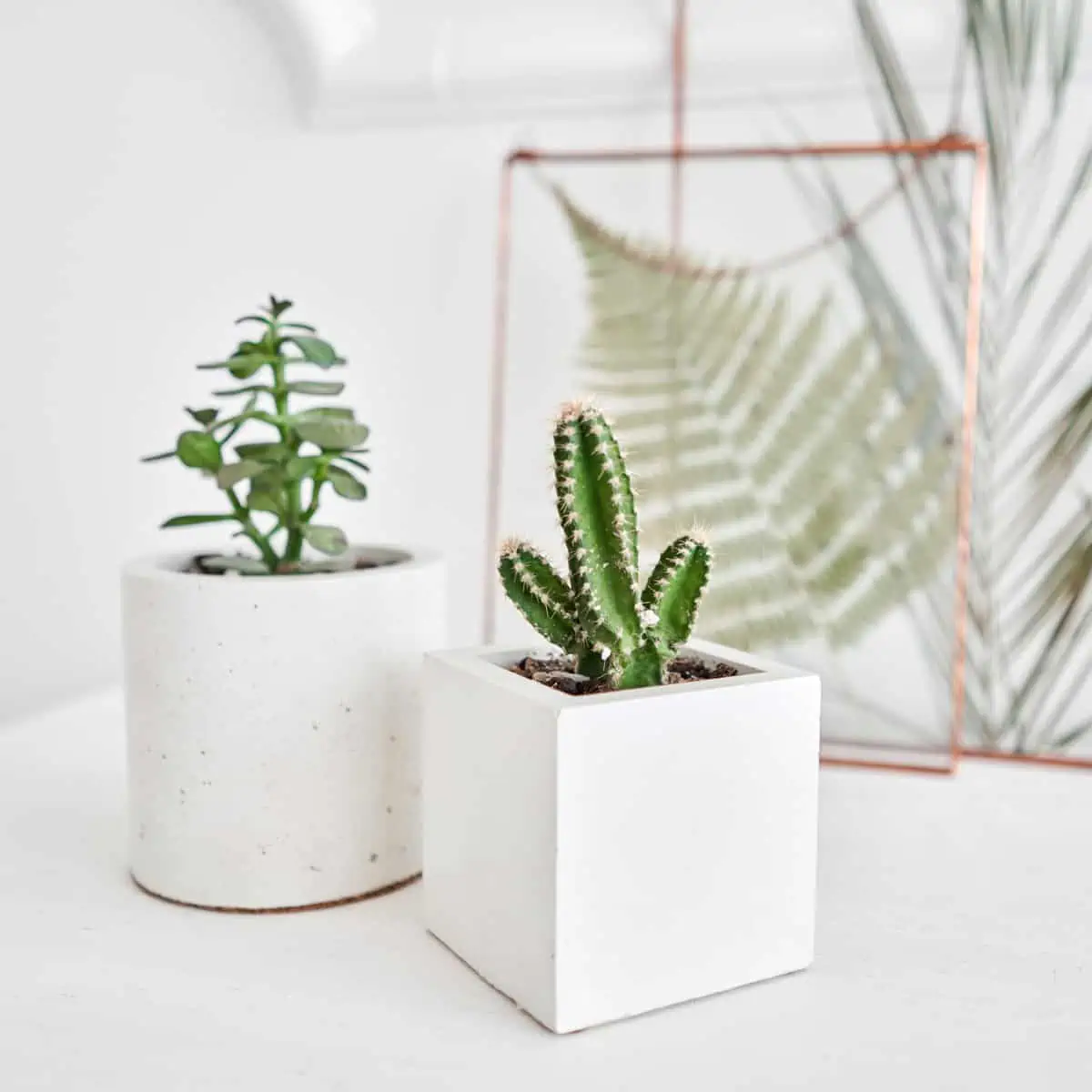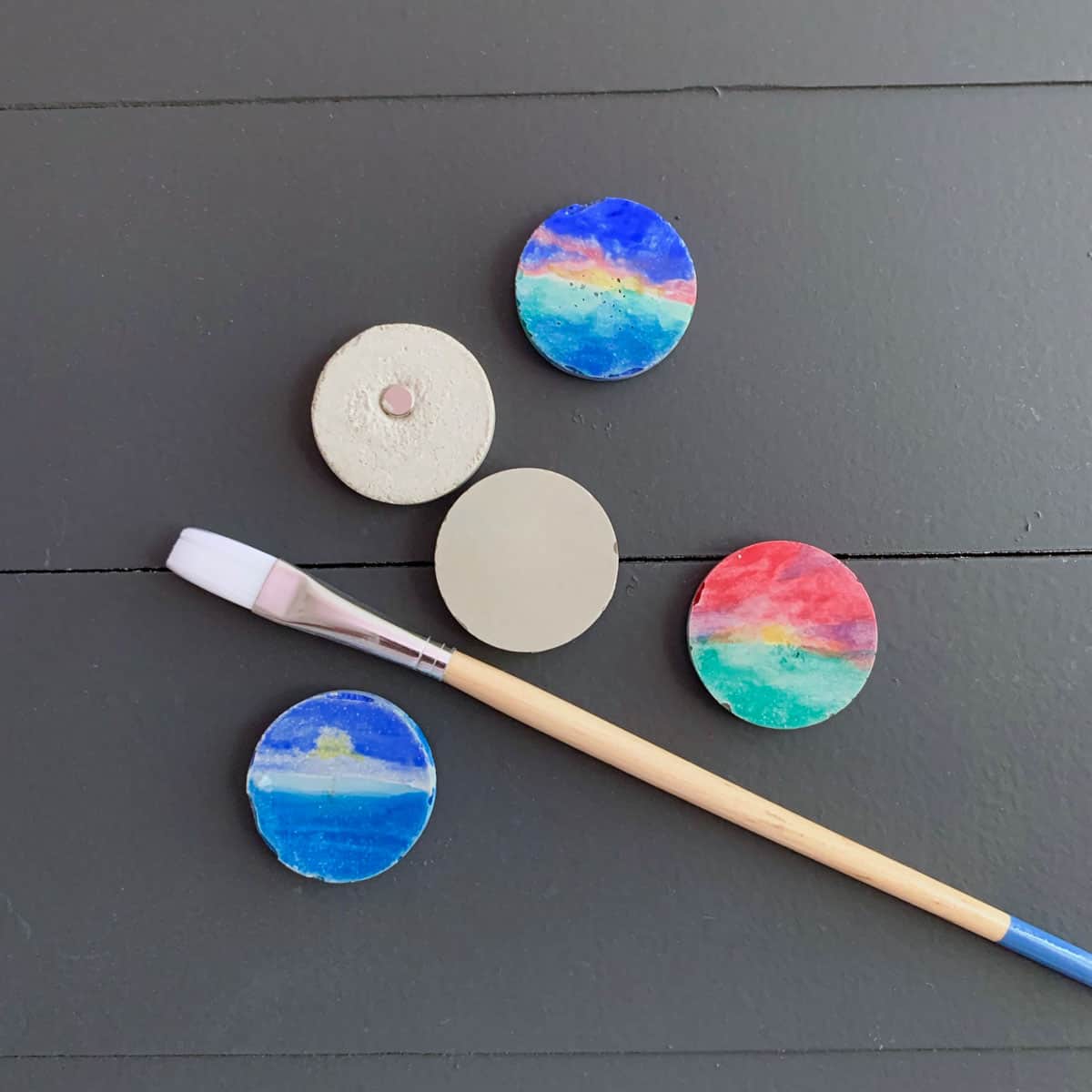How To Make Cement Crafts: Techniques & Expert Tips
Start here to learn the best techniques and advice for how to make cement crafts.
Have you been wanting to try your hand at cement crafts but don’t know where to start?
Or maybe you’ve already dabbled in a few projects, but you’re still feeling like you could use some more guidance?
If so, you’re in luck! I’ve been making concrete crafts for years, and after hundreds of concrete projects, have learned a lot along the way.
I’m excited to share my knowledge and experience with you, so that you can create beautiful and functional concrete projects that you’ll love.

Whether you’re a beginner or an experienced concrete artist, I’m sure you’ll find something helpful in this article.
I’ll cover everything from choosing the right materials to mixing, finishing, and sealing your projects.
Making things with concrete is much easier than you think. Let’s do this!
Techniques For Mixing And Pouring Concrete
How Do You Mix Concrete For Crafts?

You mix concrete for crafts with a paint stick. Even crafts sticks can work for small batches of concrete mixing.
Many people will mix concrete for DIY projects with their gloved hands.
I mix concrete by hand, rather than a mixing stick. I’m a very tactile person and like feeling things.
I like feeling the grit, so that’s part of it. The other part is that I find it is quite efficient.
By mixing cement and concrete by hand, you can get through the lumps much more easily because you can feel your way through them.
Be sure to wear durable nitrile gloves if you intend on mixing your concrete by hand.
If you don’t wear gloves for mixing cement/concrete, and it comes into contact with your skin for too long (which could be seconds), then it will burn your skin or cause it to peel later on.
This can also happen when sanding cured concrete without gloves.
Another important note about working with concrete is that you must wear a mask when mixing concrete and when sanding.
Cement and concrete contain silica which is released in the dust.
Silica is very harmful to your lungs and eyes and can even cause cancer with long term exposure.
I wrote an article where I tested six mixes. See which mix I liked best for most concrete crafts projects and why.
What Should The Cement Mix Consistency Be?

The mixture consistency will depend on what you are making and what type of cement or concrete you are working with.
Many concrete mixes that contain larger aggregate need less water than cement and will require a peanut butter-like texture- like the above photo where I used Quikrete’s High Strength mix.
In my tutorials, I specify the concrete mixture consistency.
I have an excellent, detailed article that explains a lot more about why certain mixes are stronger for some projects, but weaker and others.
It will teach you how to determine which is the best concrete mix for your project. I recommend checking it out after reading this article.
Below is the terminology that I typically refer to when talking about the cement crafts mixture consistency needed for the tutorials.
This list of terms applies to mixtures for cement crafts where smooth types of cement are being used like Portland Cement (with a 3:1 or a 2:1 cement to sand ratio), mortar mixes, Quikrete Quick Setting Cement, and CTS Cement All.
Milkshake- (slurry) typically used for a skim coat like the Cement Jack O’ Lantern.
Thick milkshake, fluid- for a skim coat or layering as with the Cement Balloon Planter or pouring/casting like the Cement Cone Vase.
This is a typical mixture consistency for casting cement into narrow cavities.
Formed, moldable: can be held in your hand, glob-like– see the cement christmas ball candles.

Cookie dough: for rolling out flat to make thinner, flat pieces like the magnetic cement key holder.
How Can I Make Concrete Stronger?
Concrete is a pretty strong substance, but sometimes it needs reinforcing and there are several ways to do this.
You can add reinforcing fibers to the mix. These fibers are made for strengthening concrete and can be made of nylon or fiberglass.
Some mixes are made with fibers already in them. Look for mixes that say GFRC or any mention of fibers.
You can also make concrete and cement stronger by adding rebar or metal rods to the mix.
This can be done with larger, flat pieces of concrete.
Mesh tape and wire mesh are also good materials that can aid in reinforcing concrete.
How Can I Speed Up Curing Times?
Concrete curing time can be sped up by curing it in warmer temperatures and with more air flow.
Keep in mind that you do risk cracking if you do this.
If the concrete starts curing too quickly due to drying out from heat, air flow and low humidity then it can make the concrete contract too much and cause cracking.
The length of time it takes concrete to cure will depend on the formula of the mix you use.
If you need a quick cure, then look for a rapid setting mix that also is quick curing.
Additionally, you can add calcium chloride to speed up the cement curing time.
However, I have not done this and don’t know what the amount is that is needed.
Most rapid or fast setting mixes are also quick curing, but not all. Be sure to check the instructions on the bag for typical cure times.
How Can I Slow Down The Setting Time Of Concrete?
You can use very cold water to slow down the setting time when working with concrete.
In warmer weather, I keep my mixing water in an ice cooler which helps a great deal in slowing down set times, giving me more time to work with the concrete.
Some manufactures make an admixture that goes into the water you mix in which will slow setting time.
These are known as retarders and will easily slow down your set time.
Concrete Making Glossary
There are many terms used when working with concrete and it’s helpful to understand what they mean.
Here are the definitions for terms commonly used in making cement and concrete crafts.
Aggregate
Aggregate is different types of materials that are added to a cement/concrete mix, typically for strengthening.
These can be things like gravel, sand, stone or slag.
Cast
When cement or concrete is poured into a mold or form.
A cement piece that is made from a mold is a casted object. This textured cement planter was cast in a silicone mold.
Cured
An object is cured when cement or concrete material has gone through the full process of hardening and has lost all of its moisture.
Demold
The process of removing the cement or concrete craft piece from its form/mold.
Integrated Color
Adding a pigment or colorant to the dry concrete mix or wet mix before the cement has set or cured.
Here are a couple of tutorials that use pigments-
Cement Cone Vase
Magnetic Cement Planters
Mini Cement Balloon Planters
For very detailed guidance on how to color concrete crafts, take a look at my Cement Pigment Tests article where I tested various ways to color cement.
Moldable
A concrete mixture that has a consistency that it is workable and readily pliable- not too stiff or too runny.
Slurry
A cement mixture consistency that is what I refer to as a milkshake consistency.
Skim Coat
A spreadable cement mixture consistency, not runny.
Set
When you can no longer insert an inner mold into an outer mold, or manipulate the cement in any way. This is not the same as cure.
Topical Color
A dye or stain that is applied after the concrete has cured.
Undercut
A divot or set-in place in your mold that when the cement is removed, it will get stuck. Undercuts will prevent you from being able to de-mold a cast piece.
If you pour concrete into a for and there is a ledge, or has indentations or angles to it, then the concrete will be wrapped around, or stuck inside and not release.
This is usually not a problem if the mold itself is flexible, like a silicone or rubber mold.
Workability (Moldability)
Whether or not the concrete is moldable- easily formed.
Working Time (Set time)
The amount of time you have to work with the cement before it has hardened past workability.
Temperature and humidity will affect the timing of this.
What Types Of Molds Can I Use For Concrete Crafts?
The good news is, there are lots of molds that you can use in concrete crafts, it’s just a matter of choosing the best for your project.
The quick list is plastic containers, melamine forms, make your own silicone mold or pre-made molds.
You can either use existing forms as concrete/cement molds or make your own. With pre-made molds, you won’t have flexibility in design.
With a pre-existing mold, you are limited by the shape. But when you make your own concrete mold, the sky’s the limit. You just need to use the proper material for your design.
Or if you want to purchase silicon mold, here are 31 really unique concrete silicone molds!
Existing Items- Repurposing

- Cooking molds that are plastic or silicone- think baking here
- Candle molds
- Pre-made silicone molds, made specifically for cement/concrete
- Plastic containers-bowls, Tupperware, sour cream containers, yogurt, leftover containers from the restaurants
*The more flexible the plastic is, the easier it will be to demold, so watch out for plastic containers that are rigid.
Build Your Own Concrete Mold
- Melamine– great for larger forms, will require using tools.
- Marker Board– easy to cut if you don’t have a power tool.
- Acetate Sheets– very flexible, inexpensive and will give you a super smooth sheen- great for inner molds.
- Corrugated Plastic Sheets- they sell these at Michaels and Home Depot. This is a fantastic material because you can just use hot glue to hold the pieces together and it’s easy to cut.
- Cardboard can be used but needs to be coated with something to not stick- use this as a last resort unless it has a waxed coating.
Pre-made Molds
- Silicone Mold– about as good of a mold as you can get. Requires mixing 2 parts at a 1:1 ratio. Typically easy to demold.
Should I Use A Lubricant With My Concrete Mold?
Some concrete molds will require a lubricant to help release the concrete from the mold. Whether you use a lubricant or not should be mostly based on the mold. A slick plastic mold with straight sides should demold easily with a lubricant.
Lubricants can leave marks on cement and concrete, or cause tiny bubbles so I try to avoid using them.
But if I need to use a mold release, I usually use a clear oil, like mineral oil and will rub it on so it doesn’t pool up.
This will help prevent discoloration marks from lubricants. You can read more about that in my article where I experimented with lubricants.
This article has more details with everything you need to know about concrete mold materials, and for help knowing which mold to choose for your concrete project.
Typical Supplies For Making Concrete Crafts
- Disposable mixing bowl- like the cheap plastic ones you can get from a dollar store.
- Very durable nitrile gloves to protect your skin!
- Plastic cups for scooping the mix.
- Disposable plastic liquid measuring cup. Though I don’t measure the water, I do use these because of the handle and pourable spout.
- Plastic bags for cleaning up any leftover cement- dry or wet.
- Safety glasses.
- Safety mask rated for silica dust.
- 220 grit sanding sponge- see sanding techniques below
- Cement All, Rapid Set -I like this mix for cement crafts since it cures in about an hour and is about as smooth of a cement mix as you can get.
Please note that when working with concrete, it’s important that you handle it safely.
Here is a detailed article on how to be safe when handling concrete.
Tools and Techniques For Demolding Concrete Crafts
What tools are best for when you have trouble removing the concrete from the mold?
Heat Gun
Use a heat gun for demolding from anything plastic and just run the gun back and forth over your project.
The heat produced from the gun will soften the plastic, making the concrete easier to remove.
Sometimes the concrete craft will just drop right out, sometimes it requires a little bit of hand flexing the plastic.
A heat gun will save you loads of time when trying to demold many concrete pieces.
Heat Tool
A heat tool can be helpful because once the tip has heated up, you can apply it to a plastic mold.
This will burn through the plastic allowing you to get a better grip with needle nose pliers so you can tear the plastic off.
Also, you can make a cut in the plastic mold from top to bottom and pull the concrete out.
However, if you use a heat tool then take care to not burn the concrete in the process.
If you get too close to it, or touch it, it will leave a mark.
Utility Knife
Utility knives are a wonderfully flexible tool in working with concrete crafts, and they are especially useful when demolding.
Use these to start a cut at the edge of plastic and then use needle nose pliers to tear the rest off.
You’ll also use these for any mold you have taped together, glued or even used silicone caulk with.
Needle-Nose Pliers
Needle-nose pliers are another must-have. These are great for grabbing corners of molds and tearing them off- assuming they are plastic.
Also, your fingers will be too slippery for many molds and these will be key in aiding with grip.
I have a complete list of concrete supplies here.
Techniques For Sanding and Finishing Concrete Crafts
How Do You Sand Concrete Crafts?
There are many ways to sand concrete and cement pieces.
Here are two methods that I’ve used, as well as two other potential methods for sanding concrete.

It may be worth purchasing a couple of these diamond sanding pads. I have the #400, #200, #100 and #60 grit pads.
I use the #60 grit and #200 grit the most. You can probably skip the #100 and #400. I only use them for the tops and the edges of planters, bowls, etc.
Why I rarely sand my cement pieces... read about my sanding tests.
220 Grit Sanding Sponge- regular
In most cases, a 220 grit sanding sponge does the trick.
However, if you are using Cement All, be sure to sand right after removing the piece from the mold or it will be too hard (literally) to do by hand.
The low grit diamond sanding pads do a great job for finishing rough edges on concrete.
There are two power tools which I haven’t used, but are used by some concrete craftspeople I know.
The first is a variable speed angle grinder, and a wet/dry one is preferred. In addition, you can use a table belt sander.
Again, I don’t have experience with these, but I wanted to let you know there are power options out there.
How Do You Seal Concrete Crafts?
You can use a brush-on concrete sealer or a spray-on sealer for sealing concrete.
These special concrete sealers come in high gloss and matte.
My preferences are these two sealers spray-on stone sealer and this dip and rub sealer.
I rarely seal any of my concrete/cement pieces, unless there is a specific reason to (like if it will be used for something that can easily get stained).
You can read about my experiments with sealer in the Cement & Concrete Tests article, and why I typically refrain from using them.
When it comes to planters, you may wish to seal them.
But if you are making a pot for succulents, then you don’t need to seal them because concrete will leach lime when wet.
The lime is highly alkaline and makes the soil alkaline which most succulents prefer.
For other plants, you can seal the concrete or leach the lime before potting by soaking the concrete pots in water for three days.
To learn more about this, you can read my article, Are Concrete Planters Safe For Plants?
It’s tough to make concrete truly waterproof without coating it with something like an epoxy resin.
To get the concrete nearly waterproof, then you can seal it. I recommend giving the concrete at least two coats of sealer inside and out.
Here’s a tutorial on how to seal a concrete planter, along with in-depth information on when it’s important to seal and when you shouldn’t.
Concrete Clean Up Tips

- A nylon brush or toothbrush
- Chore boy steel pad (doesn’t rust)
- Paper towels
- Extra bucket with water
- Rags
Set up a bucket with water and keep it next to you. As soon as you are done with your tools, you can drop them in there.
I have even used this bucket for a quick hand or finger dip when I have accidentally gotten concrete or cement on them. This will make clean-up much easier.
You can’t let concrete go down your sink drain, and other than building a concrete sink trap, this is the next best thing.
It is also helpful to have steel cleaning pads. I like Chore Boy because they don’t rust. Those do a nice job on most tools.
The next best clean up items to have on hand are a nylon brush or toothbrush. These are good for getting into crevasses.
How to deal with the leftover concrete mix? There are two ways I know of.
First, you can flex and your mixing bowl once the cement has dried and it will just break off.
However, this isn’t my favorite method since I end up cracking the bowls after only a couple of uses.
For cement bowl clean-up, I prefer using paper towels.
The best thing to do is to wipe down the bowl with a rag or paper towel immediately after using the bowl.
First, start with a dry paper towel and then usually take a wet one to go over it one last time.
Using paper towels isn’t necessarily environmentally friendly, but you better bet, I use every square inch of those babies.
However, it’s also not very environmentally friendly to throw away plastic- as I don’t believe these bowls are recyclable.
It’s a conundrum for me.
What’s Next? Have Fun With Concrete And Experiment!
Coloring Concrete Crafts
You can color concrete crafts by adding pigments to the wet or dry mix, or coloring after.
But, since I wrote entire comprehensive post dedicated to coloring concrete, I’ll direct you to that to learn about all the mediums and techniques.
Texturizing Tips
You can also get creative by adding textures to concrete. Texture is a wonderful way to bring visual interest to a cement piece.
Objects you can use are:
- string wrapped around an object
- plastic wrapped around an object
- beaded necklace wrapped around an object
- fabric or silicone designs to create an inset effect, as I did in this Succulent Design Planter tutorial
- adding aggregate like beads or colored glass
- carving lines, dots or brush marks onto the surface
The list goes on and on for all the different things you can do to jazz up concrete!
Good luck! Feel free to ask me any questions below in the comments, and check the concrete crafts tips page for all the informational resources.
Just getting started working with concrete?
Here are the five best DIY cement crafts projects for getting started.
Magnetic Cement Planters
Cement Balloon Planter
Cement Tealight Candle Holders
Modern DIY Concrete Planter
Or here’s a round up of ten of the best concrete crafts projects for beginners.
Interested in making concrete planters? This article has everything you need to know about how to make concrete plant pots.
Don’t forget to Pin it for later!

Don’t forget to Pin it for later!








Do you know how you could add vinyl to concrete? I’m wanting to add vinyl lettering with a sealant on top. Any suggestions? Thank you!
Hi Katie,
Either construction adhesive or a 2 part epoxy glue. If the pieces you are gluing are smooth and flat, then I’d use the epoxy. Otherwise, go with the construction adhesive.
You went to a lot of trouble to give so much in depth information. I’m sure it took you months if not years. Im having trouble with my concrete orbs coming out with a lot of powder/dust. I can sand until I get to a part that’s harder and not powdery. But do you know what I’m doing wrong, or what I can add to my mix that will avoid this problem? It just makes it more time consuming. The cement I was using was Alamo Cement.
Hi Tonya,
I’m not familiar with Alamo Cement. The only time I can remember having cured concrete come out powdery was when I used Glass Block Mortar Mix. And it was the mix, not anything I did, it’s just very airy. I haven’t run into powdery concrete otherwise. I think it could be the mix. I’m not sure what you’re making, but make sure the label specifies it can be used for the thickness of the piece that you are making. If it’s planter, normally I go for a mix that says from feathering to 2″. I hope that helps some. Best of luck.
can I build a Styrofoam “rock landscape” and coat it with a cement slurry such that it will hold a miniature pond of water and perhaps run water over it?
Hi Jay,
That should work, as long as it’s the appropriate thickness for the size.
Do you have any suggestions for a white concrete mix to use for small projects like trinket trays? I’ve been looking for a jesmonite alternative and I was originally going to use plaster of paris + wood glue but I’ve found so much conflicting information on whether it would be strong enough. I would really like something white so I can add color easily. It’s been really overwhelming trying to research and finding so many different answers (along with way too many terms like eco-resin, aqua-resin, cement vs concrete, etc). There is also the question of whether I can even use any of this indoors, as I live in an apartment.
Hi Daisy,
I also would be skeptical of the plaster of paris and glue. If you are in the US, some Lowe’s stores sell Glass Block Mortar Mix. It is white and is basically a smooth concrete. I have used it for many projects. One concern would be what the mold is that you are using for the boxes. It’s been durable for me on concrete planters with walls of at least 1/4″ thick. I have made coasters with it as well, but when I tried using it in a silicone mold for a planter with walls under 1/4″, it cracked.
Part of that is the mix is somewhat weak- cured to concrete, but mostly the the size of the mold and the pressure that I needed to exert on it to release the mortar from the mold. So if your mold isn’t really deep, this may work. It will cure smooth and white, and takes color well. I recommend an actual powdered pigment specifically made for concrete- everything else will have mixed or fading results. You can read more about that here:https://artsyprettyplants.com/concrete-crafts-pigments/
Here are a couple of projects I used it on.
https://artsyprettyplants.com/green-marbled-concrete-planter/
https://artsyprettyplants.com/vibrant-dyed-concrete-planter/
The end products can be used indoors, but you absolutely should not make anything with concrete, cement or mortar mix inside your house. Unfortunately, the powder will release into the air and is caustic. You must wear a mask regardless of being inside or out. And I’m not sure about plaster of paris.
Ref: Storing an unused bag for use later
Hi, over the years I’ve had a few of my bags of cement lose their ‘hold together’ ability. I actually think it was concrete. I’ve seen some people use storage containers.
What would you suggest as the best way to store it if it will be a while before using again?
Thank you so much for your information. You are amazing.
Hi,
I just answered your question on the Best Projects for Beginners article, but the long and short of it is to use a 5 gallon bucket with an air tight lid. Home Depot sells these. Mixes will expire in 6 months to a year, depending on how they are stored and exposure to humidity.
All the cement mixes you show above are creamy, the kind I bought has lots of rocks in it, is there a different cement or concrete I should buy or am I suppose to mix it differently?
Hi,
There’s so much to say about mixes! Toward the top of the post, I link to my post that tells you all about the different mixes, with pictures of them –which are smooth and which aren’t. I also do mention which are the smooth ones in this post- also near the top I think. Cement All is my favorite, by not for every project. The different articles explain in depth –why, and when to use which.
Your guide taught me more than any other resource I’ve seen from the beginning of my venture! Thank you!
Question: how do you prevent scuffs and scratches on projects from a silicon mold? Particularly when the surface is smooth…I use the eco advance sealer and cement all but they are prone to scratches still, and sanding them out ruins the smooth finish. Any suggestions?
Hi Cassandra,
I am very happy to hear that!
Unfortunately I haven’t found a way to deal with scratches without sanding, and yes, sanding will change the finish. I don’t know anyone does it and none of the sealers I’ve ever tested have prevented them. Sorry, sealers are the one thing I’ve never been fully happy with. There was one sealer I liked better than Ecco Advance (Easy Seal) but isn’t available anymore. Even that one still didn’t prevent scratches but was a little better. Rustoleum 2X clear spray will help protect the concrete even more without making the finish look bad. But it will create texture you can feel. I always use it in matte.